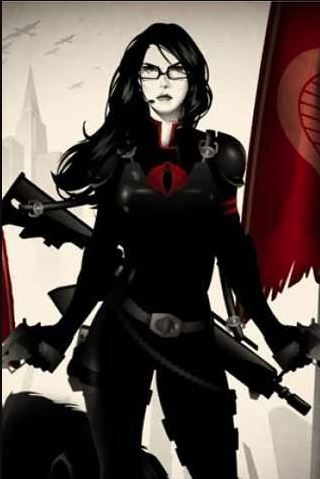Back in 2022, I wrote a blog with the premise that Fred from Scooby-Doo and Hannibal from the A-Team were one and the same person. I presented the information in a biography/documentary style. This must’ve unlocked something in my head because now I tend to find similar patterns and opportunities for strange headcanon occurrences across various media.
Today, I have another such case to present to you: What if the Baroness from G.I. Joe and Carmen Sandiego were one and the same? If you write fan fiction of either of these IPs, feel free to take this and run with it. With that in mind, let’s get started.
______________________________________________________________
Anastasia Cisarovna was born in the spring of 1960 in Toulon, France. She was an only child, and the granddaughter of Baroness Oksana Tereshchenko, a minor Russian noble who had escaped the purges that began with Tsar Nickolas II at the dawn of the October Revolution of 1917.
As the majority of the Tereshchenko fortune was based outside of Russia, Oksana had the resources to move her family to Paris. In Oksana’s personal journals, she noted that the Palace of Versailles was at first a welcome sight that reminded her of the glories of Imperial Russia, but that it, too, was the remnant of France’s own revolution against the aristocracy. She could not bear to be reminded of what she lost, so she moved the family to Marseilles. This decision would prove pivotal later in Oksana’s granddaughter’s life.
Unlike many deposed Russian nobles of the time, the Tereshchenko fortune had been preserved and thrived through the coming decades, though it was impacted by the Black Tuesday event of 1929 and the global depression that followed. The family briefly relocated to New York during World War II just before France was invaded by the Nazis in 1940.
By the time that Anastasia was born, however, France was in the midst of a post-war boom. She grew up in extreme comfort, receiving a first-rate education in Paris, London, and New York, as well as a dozen other major cities worldwide. An extremely intelligent child, Anastasia had a knack for languages and pattern recognition. Unfortunately for her private tutors and teachers, she was also quite vain and spoiled, a problem that only seemed to compound itself as she grew older. She studied ballet, played a number of musical instruments, and spoke at least six languages fluently. Yet, for all of her riches and privilege, Anastasia was never satisfied with her position. As the sole heiress to her family’s fortune, it was widely believed that she be subject to any number of hunters looking to add the sum of the Tereshchenko wealth to their coffers.

This resulted in her revolting against the very class that had kept her in such luxury during her life. She became involved with student activism at age 17, and her fervor led her ever more into fringe groups with increasingly radical agendas. Over time, this instilled a bone-deep hatred of the United States and its institutions in her, however her own bitter family history with the Soviet Union made her distrustful of communism in general. For Anastasia, there was no super power in the late 70s that could quite fit the paradoxical idea she had of a society with an established ruling class, though one where the Peers of the realm achieved their status through meritocracy.
Through these fringe groups, Anastasia met a Scottish Laird who had become an international arms dealer, the founder of the M.A.R.S. corporation, James McCullen Destro XXIV, often shortened to simply “Destro.” While involved in a myriad of hot zones from Africa to South America, Destro comported himself with a kind of honor that Anastasia found compelling, including his love of music. While they would go their separate ways after a brief romantic interlude in the Republic of the Congo, Destro had opened Anastasia’s eyes to the wider world of political terrorism, insurgency, and special operations. The thrill of it, the duplicity, and intrigue of it all, called to her. It was during this time that she became proficient in small arms, particularly the M-16, AK-47, Uzi, and RPG-7, along with virtually all handguns.
She moved to Berlin in 1979, becoming involved in the political interplay of West and East Germany, where she gained a first-rate education in intelligence gathering, cryptography, disguise, and psychological warfare. Often she played both sides to her advantage, never staying with the same faction or organization for very long. During this time, she went by the alias “Anna Von Stromberg,” but often adopted her signature nom de guerre from her grandmother’s title: The Baroness.
By the age of 21, she had cemented herself as a major player on both sides of the Iron Curtain, sometimes running operations in tandem with Destro in dozens of different countries. It was through these machinations that the two of them were contacted, and later recruited, by a shadowy figure calling himself “The Commander.” With a manifesto espousing world domination, and seemingly unlimited resources and technology, both Destro and the Baroness saw their opportunity to increase their station within this new organization, which the Commander dubbed “COBRA.”
Becoming part of the leadership of COBRA proved to have its own challenges, however. The Commander and Destro were constantly at odds with each other. Much like in Berlin, she was able to play both mens’ egos against each other while strangely showing them both loyalty at the same time. During this time, she met notable legends that would come to be colleagues during her residence at the Terrordrome, including: Storm Shadow, a ninja of the Arashikage clan; Major Sebastian Bludd; Zartan and Zartana, the masters of disguise; Dr Brian Binder, a brilliant geneticist; and the twins, Tomax and Xamot, COBRA’s legal and financial experts.
Over the course of the next few years, COBRA would clash with a nascent faction emerging from the United States Armed Forces, a daring, highly trained special mission force, codenamed: G.I. Joe. Anastasia herself would spark this long-standing rivalry by personally abducting, and later impersonating, Dr. Adele Burkhart, one of the world’s top nuclear physicists. This would be the first of many operations she would run in opposition to the Joes. In one such night mission, however, Anastasia was severely burned and required extensive plastic surgery to recover. She would routinely continue this practice to alter her appearance to keep her one step ahead of the Joes, Interpol, and any other law enforcement agencies or para-military groups arrayed against her.
Unfortunately, despite all their guile, cunning, and advanced technology, COBRA fought a slowly losing battle against G.I. Joe. This culminated in the Commander’s overthrow as the head of the organization in 1986 by Cobra Emperor Serpentor, a composite clone created by Destro and Dr. Binder from some of history’s most ruthless leaders, including: Attila the Hun, Hannibal of Carthage, Napoleon Bonaparte, and Julius Caesar. While a charismatic leader, and fearless in combat, Serpentor proved to be dangerously unstable and cruel.
By the following year in 1987, things had come to a head between the Commander and the Emperor. The conflict was soon overshadowed by the revelation of Cobra-La, a hitherto unknown precursor civilization of non-humans that had survived the previous Ice Age of 40,000 years ago by tunneling deep beneath Himalayan Mountains. They revealed that the Commander was, in fact, one of their scientists and noblemen, who was tasked with the destruction of the outside world. His repeated failures, however, prompted them to influence the dreams of Destro and Doctor Binder to create Serpentor. By the end of this conflict, Cobra Commander had been exposed to spores that transform him, ironically, into a cobra. Serpentor met his match against a green beret, codenamed Falcon, who crashed the Emperor’s air chariot, presumably killing the Emperor.
With both COBRA leaders gone, Destro and the Baroness rallied their remaining troops back at their base in Springfield, Missouri. The Joes did not relent in their pursuit, and laid siege to their headquarters at the Battle of Springfield, which would see Destro lost in action (though not officially KIA), Tomax and Xamot put in jail, and most of the other COBRA leadership neutralized or on the run. Only the Baroness and Storm Shadow would escape from this final showdown, due largely in part with a well-timed smoke bomb.

Shortly after, Storm Shadow would depart for Japan and vanish from the world stage, leaving Anastasia in sole command of the COBRA remnants, including the sizeable portion of the elite Crimson Guard. Before he left, however, as a final parting gift, it’s believed that he shared some of his knowledge of Arashikage ninjutsu, including infiltration and evasion techniques with her.
Now concentrated at COBRA’s undiscovered satellite base in San Diego, California, Anastasia realized that COBRA’s aims were too lofty and based on violent coercion, she began to reformat the last of COBRA into an entirely new organization. No more would they be international terrorists, but would instead deal in grand theft, smuggling, and political intrigue. She renamed them VILE, the spiritual successor to COBRA, using the same network of international contacts, though emphasizing cunning and non-violent schemes.
During this time, the Crimson Guard began calling Anastasia “Carmen” in a nod to the color carmine red. That, along with the location of their base of operations saw Anastasia leave behind her persona of the Baroness permanently and adopt Carmen Sandiego as her new alias. Using some longevity spores she recovered from Cobra-La, she greatly slowed down her aging process. The rejuvenation even allowed her to retire the corrective glasses she had always worn.
Donning a red trench coat and matching fedora, she rebranded herself as a confidence man and dashing international jewel thief. Then, at the moment of her transformation, something strange happened: She quit VILE, leaving one of her lieutenants in charge, and tried to make an honest go of her life. This coincided with her loss of access to the Tereshchenko fortune, which deprived her of the incredible riches she had been accustomed to her entire life.
Returning to her home in Toulon to determine her next move, she chanced to meet an agent of the intelligence service of nearby Monaco. Saving him and his family while on vacation from a mafia hit squad, the agent immediately recruited her into the General Intelligence Division of Monaco, though her true identity remained unknown.
Hunting down criminals with the agency was almost too easy for her given her background and knowledge of the criminal underworld. Later, she was recommended to a newly formed international agency based in the United States simply known as ACME. She proved an incredible asset for them as well, but soon found she could not entirely evade her past. Many of the agents at ACME, colloquially known as “gumshoes,” were former G.I. Joe operatives. The Chief of ACME operations, Moira Hinton, was, in fact, the older sister of Sergeant First Class Marvin Hinton, otherwise known by his Joe codename, Roadblock.
Carmen worked diligently in their offices, and no one, it seemed, could smoke out criminals quite like she could. Success was effortless for her, but continued contact with wealthy criminals, and the opulence they enjoyed rekindled her want of the finer things that had been deprived her since the loss of her inheritance. Eventually, she formed a bold plan: She would put as many of her criminal competitors out of business before returning to her life of crime. Once she had collected as much information from ACME’s mainframe as she could, she disappeared, returning to VILE, resuming a leadership position and personally pulling off major heists, even against seemingly impenetrable security systems.

In the years that would follow, she would run operations in the place as diverse as Kiev to the Carolinas. She would run ponzi scams in the Scandinavian countries, and was responsible for the theft of a trio of rare blue diamonds that were national treasures in the Islamic Republic of Pakistan. From the back streets of Harare to the Mayan ruins of Belize, Carmen seemed to be everywhere and virtually uncatchable. Time and time again, agents of ACME would catch up with her only for her to give them the slip at the last minute.

Even now, years later, she remains at large with ACME and Interpol always in pursuit. As of 2024, at the age of 64, she looks and acts no different than she did when she was in her early thirties. She remains a fugitive from justice, a ghost, with her whereabouts unknown.
Though she no longer carries a weapon aside from her trusty grappling hook launcher, it is believed that if her red coat were to ever to fall open, her old black body armor, emblazoned with a bright red COBRA insignia across the chest, would be visible, just underneath.
______________________________________________________________
There you have it, folks. Once again, if you write fan fiction, feel free to take this idea and go forward with my blessing. Extra points for any fanart that comes of this. Just keep it tasteful, okay?
Thank you for following me on this strange (but fun) thought experiment. As I make more mental connections between various IPs and fandoms, I’ll make this series a semi-regular part of my blog lineup.
Thanks for reading!














